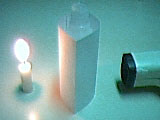


|
Aerodynamics
Science at Home |
||
|
Materials
|
|
Videos: download.avi (379 KB)
Pictures: 

|
|
Procedure
1. Cut the paper leaf in two parts. 2. Fold the papers parts in half and with ribbon glue link the opposite tips of each one. Air should not be allowed to get into the paper structure. 3. Place a glass inside the paper structure. In this way you will have an oval paper structure to study the properties of air dynamics. 4. Light the candle with matches and place it behind the paper structure. 5. Place the paper structure in a way that the fold borders are vertical in comparison to the candle. (the candle should stay in the middle of the paper) 6. Place the hair dryer in the opposite side of the candle and turn it on. 7. Rotate the paper structure slowly in a way that the fold tips are turning for the air flow. (in the rotation movement end you will verify that the candle fire will turn off due to the stronger air flow in its direction) |
||
|
Why?
To minimize the attrition imposed to air flow in a object surface, several forms called aerodynamic have been developed. This modern object design implies a minimum resistance to air flow turbulence in its surfaces. |
||
 |
No part of this website can be reproduced without previous authorization. Please inform me if there is any problem with the website. |